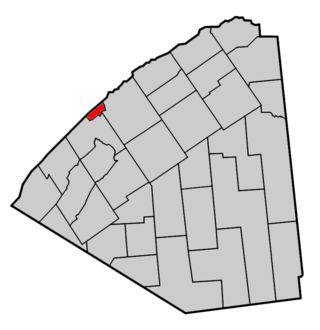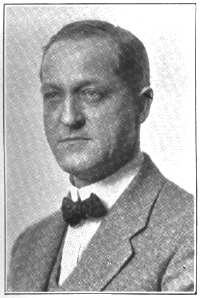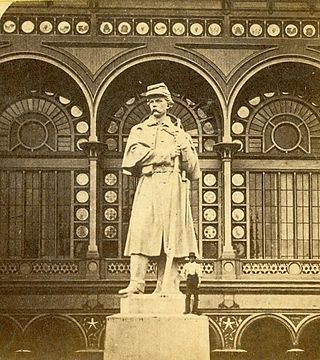
Ogdensburg is a city in St. Lawrence County, New York, United States. The population was 10,436 at the 2019 census. In the late 18th century, European-American settlers named the community after American land owner and developer Samuel Ogden. The city is at the northern border of New York at the mouth of the Oswegatchie River on the south bank of the St. Lawrence River. The only formally designated city in the county, it is located between Massena, New York to the east and Brockville, Ontario to the west.

Woodlawn Cemetery is one of the largest cemeteries in New York City and a designated National Historic Landmark. Located south of Woodlawn Heights, Bronx, New York City, it has the character of a rural cemetery. Woodlawn Cemetery opened during the Civil War in 1863, in what was then southern Westchester County, in an area that was annexed to New York City in 1874. It is notable in part as the final resting place of some well-known figures.

Felix Weihs de Weldon was an American sculptor. His most famous pieces include the United States Marine Corps War Memorial in the Arlington National Cemetery, Virginia, US, and the Malaysian National Monument (1966) in Kuala Lumpur.

Gertrude Vanderbilt Whitney was an American sculptor, art patron and collector, and founder in 1931 of the Whitney Museum of American Art in New York City. She was a prominent social figure and hostess, who was born into the wealthy Vanderbilt family and married into the Whitney family.

Frederic Sackrider Remington was an American painter, illustrator, sculptor, and writer who specialized in the genre of Western American Art. His works are known for depicting the Western United States in the last quarter of the 19th century and featuring such images as cowboys, American Indians, and the US Cavalry.

William Rudolf O'Donovan was an American sculptor.

Charles Henry Niehaus was an American sculptor.

Caspar Buberl was an American sculptor. He is best known for his Civil War monuments, for the terra cotta relief panels on the Garfield Memorial in Cleveland, Ohio, and for the 1,200-foot (370 m)-long frieze on the Pension Building in Washington, D.C.

George Edwin Bissell was an American sculptor.

Attilio Piccirilli was an American sculptor. Born in Massa, Italy, he was educated at the Accademia di San Luca of Rome.

Samuel James Kitson was a British-American sculptor active in the United States from about 1876 to 1906. He maintained studios in New York City and Boston.
Roman Bronze Works, now operated as Roman Bronze Studios, is a bronze foundry in New York City. Established in 1897 by Riccardo Bertelli, it was the first American foundry to specialize in the lost-wax casting method, and was the country's pre-eminent art foundry during the American Renaissance.

John Paulding was an American sculptor best remembered for his World War I memorials. Paulding was born in Darke County, Ohio. He studied sculpture at the Art Institute of Chicago and was to remain in Chicago until his death at an early age in 1935.

Brenda Putnam was an American sculptor, teacher and author.

Edmond Thomas Quinn was an American sculptor and painter. He is best known for his bronze statue of Edwin Booth as Hamlet, which stands at the center of Gramercy Park in New York City. His larger-than-lifesize bronze bust of Victor Herbert stands near The Pond in Central Park, New York City.

Carl H. Conrads was an American sculptor best known for his work on Civil War monuments and his two works in the National Statuary Hall Collection at the U.S. Capitol in Washington, D.C. He was also known as Charles Conrads.

Giovanni Turini was an American sculptor, born in Verona, Italy. He immigrated to the United States in the late 1860s. He is best remembered as a portrait and historical sculptor.

An equestrian statue of Simón Bolívar, sometimes called the Simón Bolívar Monument, is installed in Manhattan's Central Park, in the U.S. state of New York. The memorial features a bronze sculpture by Sally James Farnham resting on a black granite pedestal designed by the firm Clarke and Rapuano. It was cast in 1919, dedicated on April 19, 1921, rededicated on April 19, 1951, and conserved by the Adopt-a-Monument Program in 1988.

Bruno Louis Zimm was an American sculptor. He created a variety of works: fountains, memorials, freestanding sculptures, and architectural sculptures.























